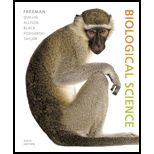
Concept explainers
Choose the best definition of a fossil.
a. any trace of an organism that has been converted into rock
b. a bone, tooth, shell, or other hard part of an organism that has been preserved
c. any trace of an organism that lived in the past
d. any part of a dead organism
Introduction:
The shells, bones, teeth, hair, exoskeletons, or stone imprints are included in the fossils. They are studied for their age, formation process, and significance in evolution. The study of the fossil is called paleontology and the totality of fossil is termed as fossil records.
Answer to Problem 1TYK
Correct answer:
The fossil is any trace of an organism that lived in the past. The preserved remains or traces of any part or whole of an organism that was once living, are called fossils.
Explanation of Solution
Explanation/Justification for the correct answer:
Option (c) is given as any organism traces that lived in the past. The fossil can be explained as the remains or traces of an organism, which was once living. The fossils are the physical proof or evidence that gives information about the organisms that once lived in the past. Hence, option (c) is correct.
Explanation for incorrect answers:
Option (a) is given as any organism’s traces that are converted into rocks. These are formed when a part or the whole organism gets buried under a lot of pressure in the sand, mud, or ash. The course of time causes mineralization of the organism, which then turns into fossils. So, it is an incorrect option.
Option (b) is given as any hard parts that have been preserved. Soft parts of the organisms that are preserved can also be considered as fossilized remains. So, it is an incorrect option.
Option (d) is given as any part of a dead organism. It is not necessary that only a dead organism that has been preserved may be described as a fossil. So, it is an incorrect option.
Hence, options (a), (b), and (d) are incorrect.
The hard traces or remains of an organism that had once lived in the past, like bones, teeth, and shells get converted into rocks. The soft traces like hair are also preserved but not in the form of a rock. Thus, the fossil is any part of the dead organism that has been preserved, and which serves as a trace to study that organism.
Want to see more full solutions like this?
Chapter 25 Solutions
Biological Science (6th Edition)
- What is the concept "calories consumed must equal calories burned" in regrads to nutrition?arrow_forwardYou intend to insert patched dominant negative DNA into the left half of the neural tube of a chick. 1) Which side of the neural tube would you put the positive electrode to ensure that the DNA ends up on the left side? 2) What would be the internal (within the embryo) control for this experiment? 3) How can you be sure that the electroporation method itself is not impacting the embryo? 4) What would you do to ensure that the electroporation is working? How can you tell?arrow_forwardDescribe a method to document the diffusion path and gradient of Sonic Hedgehog through the chicken embryo. If modifying the protein, what is one thing you have to consider in regards to maintaining the protein’s function?arrow_forward
- The following table is from Kumar et. al. Highly Selective Dopamine D3 Receptor (DR) Antagonists and Partial Agonists Based on Eticlopride and the D3R Crystal Structure: New Leads for Opioid Dependence Treatment. J. Med Chem 2016.arrow_forwardThe following figure is from Caterina et al. The capsaicin receptor: a heat activated ion channel in the pain pathway. Nature, 1997. Black boxes indicate capsaicin, white circles indicate resinferatoxin. You are a chef in a fancy new science-themed restaurant. You have a recipe that calls for 1 teaspoon of resinferatoxin, but you feel uncomfortable serving foods with "toxins" in them. How much capsaicin could you substitute instead?arrow_forwardWhat protein is necessary for packaging acetylcholine into synaptic vesicles?arrow_forward
- 1. Match each vocabulary term to its best descriptor A. affinity B. efficacy C. inert D. mimic E. how drugs move through body F. how drugs bind Kd Bmax Agonist Antagonist Pharmacokinetics Pharmacodynamicsarrow_forward50 mg dose of a drug is given orally to a patient. The bioavailability of the drug is 0.2. What is the volume of distribution of the drug if the plasma concentration is 1 mg/L? Be sure to provide units.arrow_forwardDetermine Kd and Bmax from the following Scatchard plot. Make sure to include units.arrow_forward
- Choose a catecholamine neurotransmitter and describe/draw the components of the synapse important for its signaling including synthesis, packaging into vesicles, receptors, transporters/degradative enzymes. Describe 2 drugs that can act on this system.arrow_forwardThe following figure is from Caterina et al. The capsaicin receptor: a heat activated ion channel in the pain pathway. Nature, 1997. Black boxes indicate capsaicin, white circles indicate resinferatoxin. a) Which has a higher potency? b) Which is has a higher efficacy? c) What is the approximate Kd of capsaicin in uM? (you can round to the nearest power of 10)arrow_forwardWhat is the rate-limiting-step for serotonin synthesis?arrow_forward

 Concepts of BiologyBiologyISBN:9781938168116Author:Samantha Fowler, Rebecca Roush, James WisePublisher:OpenStax College
Concepts of BiologyBiologyISBN:9781938168116Author:Samantha Fowler, Rebecca Roush, James WisePublisher:OpenStax College Biology Today and Tomorrow without Physiology (Mi...BiologyISBN:9781305117396Author:Cecie Starr, Christine Evers, Lisa StarrPublisher:Cengage Learning
Biology Today and Tomorrow without Physiology (Mi...BiologyISBN:9781305117396Author:Cecie Starr, Christine Evers, Lisa StarrPublisher:Cengage Learning Biology (MindTap Course List)BiologyISBN:9781337392938Author:Eldra Solomon, Charles Martin, Diana W. Martin, Linda R. BergPublisher:Cengage Learning
Biology (MindTap Course List)BiologyISBN:9781337392938Author:Eldra Solomon, Charles Martin, Diana W. Martin, Linda R. BergPublisher:Cengage Learning Human Biology (MindTap Course List)BiologyISBN:9781305112100Author:Cecie Starr, Beverly McMillanPublisher:Cengage Learning
Human Biology (MindTap Course List)BiologyISBN:9781305112100Author:Cecie Starr, Beverly McMillanPublisher:Cengage Learning Biology: The Dynamic Science (MindTap Course List)BiologyISBN:9781305389892Author:Peter J. Russell, Paul E. Hertz, Beverly McMillanPublisher:Cengage Learning
Biology: The Dynamic Science (MindTap Course List)BiologyISBN:9781305389892Author:Peter J. Russell, Paul E. Hertz, Beverly McMillanPublisher:Cengage Learning





